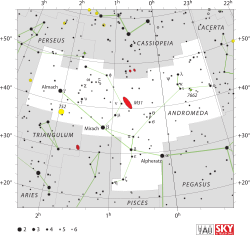Kappa Andromedae

| |
| Observation data Epoch J2000 Equinox J2000 | |
|---|---|
| Constellation | Andromeda |
| Right ascension | 23h 40m 24.50763s[1] |
| Declination | +44° 20′ 02.1566″[1] |
| Apparent magnitude (V) | 4.139[2] |
| Characteristics | |
| Spectral type | B9 IVn[3] |
| U−B color index | -0.221[2] |
| B−V color index | -0.067[2] |
| Astrometry | |
| Radial velocity (Rv) | -15.0[4] km/s |
| Proper motion (μ) | RA: +80.73[1] mas/yr Dec.: -18.70[1] mas/yr |
| Parallax (π) | 19.37 ± 0.19[1] mas |
| Distance | 168 ± 2 ly (51.6 ± 0.5 pc) |
| Details | |
| Radius | 2.31 ± 0.09[5] R☉ |
| Surface gravity (log g) | 4.10 ± 0.03[5] cgs |
| Temperature | 11,361 ± 66[5] K |
| Rotational velocity (v sin i) | 176[6] km/s |
| Other designations | |
| Database references | |
| SIMBAD | data |
Kappa Andromedae (κ And, κ Andromedae) is the Bayer designation for a bright star in the constellation of Andromeda. Its apparent visual magnitude is 4.1.[2] Based on the star's ranking on the Bortle Dark-Sky Scale, it is luminous enough to be visible from the suburbs and from urban outskirts, but not from brightly lit inner city regions. Parallax measurements made during the Hipparcos mission place it at a distance of approximately 168 light-years (52 parsecs) from Earth.[1]
Kappa Andromedae has a stellar classification of B9 IVn,[3] indicating that it is a subgiant star in the process of evolving away from the main sequence. It has 2.3[5] times the radius of the Sun and is spinning rapidly, with a projected rotational velocity of 176 km/s.[6] The outer envelope of the star is radiating energy into space with an effective temperature of 11,361 K,[5] producing a blue-white hue.
Naming
In Chinese, 螣蛇 (Téng Shé), meaning Flying Serpent, refers to an asterism consisting of κ Andromedae, α Lacertae, 4 Lacertae, π2 Cygni, π1 Cygni, HD 206267, ε Cephei, β Lacertae, σ Cassiopeiae, ρ Cassiopeiae, τ Cassiopeiae, AR Cassiopeiae, 9 Lacertae, 3 Andromedae, 7 Andromedae, 8 Andromedae, λ Andromedae, ι Andromedae, and ψ Andromedae. Consequently, κ Andromedae itself is known as 螣蛇二十一 (Téng Shé èrshíyī, English: the Twenty First Star of Flying Serpent).[7]
System

In November 2012, a young, hot gas giant planet about 13 times the mass of and slightly larger than Jupiter was directly imaged in orbit around κ And at a projected separation of 55 ± 2 AU.[8]
Observations at multiple wavelengths indicate a temperature of about 1700 K and the estimated age is approx. 30 million years.[8]
In September 2013, the mass of the companion was revised to be 50±13 Jupiter masses due to a much older estimated age for the star, 220±100 million years.[9] The companion is shining by its residual heat of formation, cooling as it ages. As a result, an older system age implies a larger mass (and initial supply of energy) to reach the same current brightness. This more recent study used data from the Project 1640 integral-field spectrograph to fit a temperature of about 2040 K.[9]
| Companion (in order from star) |
Mass | Semimajor axis (AU) |
Orbital period (days) |
Eccentricity | Inclination | Radius |
|---|---|---|---|---|---|---|
| b | 50+16 −13 MJ |
55±2 | — | — | — | — |
See also
- List of extrasolar planets directly imaged
References
- ↑ 1.0 1.1 1.2 1.3 1.4 1.5 van Leeuwen, F. (November 2007), "Validation of the new Hipparcos reduction", Astronomy and Astrophysics 474 (2): 653–664, arXiv:0708.1752, Bibcode:2007A&A...474..653V, doi:10.1051/0004-6361:20078357
- ↑ 2.0 2.1 2.2 2.3 Harmanec, P. et al. (1980), "Photoelectric photometry at the Hvar Observatory. IV - A study of UBV variations of a group of bright northern Be stars", Bulletin of the Astronomical Institutes of Czechoslovakia, Bulletin 31 (3): 144–159, Bibcode:1980BAICz..31..144H
- ↑ 3.0 3.1 Cowley, A. et al. (April 1969), "A study of the bright A stars. I. A catalogue of spectral classifications", Astronomical Journal 74: 375–406, Bibcode:1969AJ.....74..375C, doi:10.1086/110819
- ↑ Palmer, D. R. et al. (1968), "The radial velocities spectral types and projected rotational velocities of 633 bright northern A stars", Royal Observatory Bulletin 135: 385, Bibcode:1968RGOB..135..385P
- ↑ 5.0 5.1 5.2 5.3 5.4 Fitzpatrick, E. L.; Massa, D. (March 2005), "Determining the Physical Properties of the B Stars. II. Calibration of Synthetic Photometry", The Astronomical Journal 129 (3): 1642–1662, arXiv:astro-ph/0412542, Bibcode:2005AJ....129.1642F, doi:10.1086/427855
- ↑ 6.0 6.1 Royer, F.; Zorec, J.; Gómez, A. E. (February 2007), "Rotational velocities of A-type stars. III. Velocity distributions", Astronomy and Astrophysics 463 (2): 671–682, arXiv:astro-ph/0610785, Bibcode:2007A&A...463..671R, doi:10.1051/0004-6361:20065224
- ↑ (Chinese) AEEA (Activities of Exhibition and Education in Astronomy) 天文教育資訊網 2006 年 7 月 7 日
- ↑ 8.0 8.1 Carson et al. (November 2012). "Direct Imaging Discovery of a ‘Super-Jupiter’ Around the late B-Type Star κ And". arXiv:1211.3744.
- ↑ 9.0 9.1 Sasha Hinkley, Laurent Pueyo, Jacqueline K. Faherty, Ben R. Oppenheimer, Eric E. Mamajek, Adam L. Kraus, Emily L. Rice, Michael J. Ireland, Trevor David, Lynne A. Hillenbrand, Gautam Vasisht, Eric Cady, Douglas Brenner, Aaron Veicht, Ricky Nilsson, Neil Zimmerman, Ian R. Parry, Charles Beichman, Richard Dekany, Jennifer E. Roberts, Lewis C Roberts Jr., Christoph Baranec, Justin R. Crepp, Rick Burruss, J. Kent Wallace, David King, Chengxing Zhai, Thomas Lockhart, Michael Shao, Remi Soummer, Anand Sivaramakrishnan, Louis A. Wilson (September 2013). "The Kappa Andromedae System: New Constraints on the Companion Mass, System Age & Further Multiplicity". arXiv:1309.3372.
External links
| ||||||||||||||||||||||||||||||||||||||||||||||||||||||||||||||||||||||